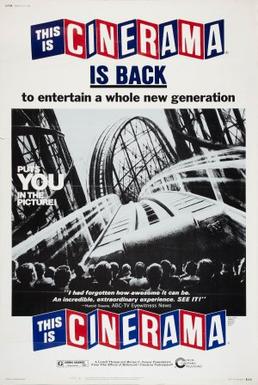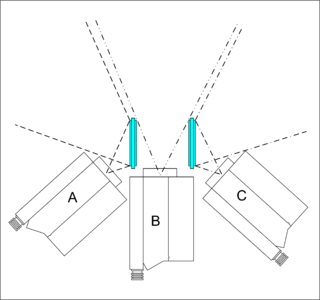Related Research Articles

How the West Was Won is a 1962 American epic Western film directed by Henry Hathaway, John Ford and George Marshall, produced by Bernard Smith, written by James R. Webb, and narrated by Spencer Tracy. Originally filmed in true three-lens Cinerama with the according three-panel panorama projected onto an enormous curved screen, the film stars an ensemble cast consisting of Carroll Baker, Lee J. Cobb, Henry Fonda, Carolyn Jones, Karl Malden, Gregory Peck, George Peppard, Robert Preston, Debbie Reynolds, James Stewart, Eli Wallach, John Wayne and Richard Widmark. The supporting cast features Brigid Bazlen, Walter Brennan, David Brian, Ken Curtis, Andy Devine, Jack Lambert, Raymond Massey as Abraham Lincoln, Agnes Moorehead, Harry Morgan as Ulysses S. Grant, Thelma Ritter, Mickey Shaughnessy, Harry Dean Stanton, Russ Tamblyn and Lee Van Cleef.

This Is Cinerama is a 1952 American documentary film directed by Mike Todd, Michael Todd, Jr., Walter A. Thompson and Fred Rickey and starring Lowell Thomas. It is designed to introduce the widescreen process Cinerama, which broadens the aspect ratio so that the viewer's peripheral vision is involved. This Is Cinerama premiered on September 30, 1952, at the Broadway Theatre in New York City.

Cinerama is a widescreen process that originally projected images simultaneously from three synchronized 35mm projectors onto a huge, deeply curved screen, subtending 146-degrees of arc. The trademarked process was marketed by the Cinerama corporation. It was the first of several novel processes introduced during the 1950s when the movie industry was reacting to competition from television. Cinerama was presented to the public as a theatrical event, with reserved seating and printed programs, and audience members often dressed in their best attire for the evening.

Pacific Theatres' Cinerama Dome is a movie theater located at 6360 Sunset Boulevard in Hollywood, California. Designed to exhibit widescreen Cinerama films, it opened November 7, 1963. The original developer was William R. Forman, founder of Pacific Theatres. The Cinerama dome continued as a leading first-run theater, most recently as part of the ArcLight Hollywood complex, until it closed temporarily in March 2020, due to the COVID-19 pandemic in California. The Arclight chain closed permanently in April 2021, with the theater never having reopened. In June 2022, it was announced that there are plans to reopen under the new name, Cinerama Hollywood.

The Prince Edward Theatre is a West End theatre situated on Old Compton Street, just north of Leicester Square, in the City of Westminster, London.

Cinemiracle was a widescreen cinema format competing with Cinerama developed in the 1950s. It was ultimately unsuccessful, with only a single film produced and released in the format. Like Cinerama it used 3 cameras to capture a 2.59:1 image. Cinemiracle used two mirrors to give the left and right cameras the same optical center as the middle camera. This made the joins between the projected images much less obvious than with Cinerama.
The Indian Hills Theater in Omaha, Nebraska, United States, was a movie theater built in 1962 showcasing films in the Cinerama wide-screen format. Its location was at 8601 West Dodge Rd. The theater's screen was the largest of its type in the United States. Despite the protests of local citizens, Hollywood legends, and the National Trust for Historic Preservation, the theater was demolished in 2001 by Nebraska Methodist Health System for a parking lot.
Super Technirama 70 was the marketing name for a special type of deluxe film exhibition that was most popular in the 1960s. It was the 70mm version of the Technirama exhibition format.

The Seattle Cinerama Theatre is a landmark movie theater in Seattle, Washington, United States. Located in the city's Belltown neighborhood, it was one of only three movie theaters in the world capable of showing three-panel Cinerama films until it closed in May 2020.
Kinopanorama is a three-lens, three-film widescreen film format. Although Kinopanorama was initially known as Panorama in the Soviet Union the name was later revised to include its current name prior to the premiere screenings in Moscow in 1958. In some countries, including Cuba, Greece, Norway and Sweden, it was usually marketed as Soviet Cinerama. When Great Is My Country and The Enchanted Mirror, were exhibited at the Mayfair Theatre in New York City in 1958, it was briefly advertised as Cinepanorama. Kinopanorama is for the most part identical in operation to that of Fred Waller's American-designed Cinerama format.

The Wonderful World of the Brothers Grimm is a 1962 American fantasy film directed by Henry Levin and George Pal. The latter was the producer and also in charge of the stop motion animation. The film was one of the highest-grossing films of 1962. It won one Oscar and was nominated for three additional Academy Awards. Several prominent actors—including Laurence Harvey, Karlheinz Böhm, Jim Backus, Barbara Eden, and Buddy Hackett—are in the film.
Cinerama Adventure is a 2002 documentary about the history of the Cinerama widescreen film process. It tells the story of the widescreen process' evolution, from a primitive multi-screen pyramid process to a Vitarama format that played a big part in World War II, to the three-screen panoramic process it eventually became. The film includes interviews with surviving cast and crew who personally worked on the Cinerama films, plus vintage interviews with late creator Fred Waller.

Custer of the West is a 1967 American Western film directed by Robert Siodmak that presents a highly fictionalised version of the life and death of George Armstrong Custer, starring Robert Shaw as Custer, Robert Ryan, Ty Hardin, Jeffrey Hunter, and Mary Ure. The film was shot entirely in Spain.

The Last Drop of Water is a 1911 American short silent Western film directed by D. W. Griffith and starring Blanche Sweet. Three known prints of the film survive. It was filmed in the San Fernando desert as well as Lookout Mountain, California. The film was considered the "most ambitious film made by Griffith during the California trip of 1911" before the Biograph company moved back to New York. It was filmed on or between the 14 May and May 20, 1911. It was reissued by Biograph August 13, 1915.
Cinerama Releasing Corporation (CRC) was a motion picture company established in 1967 that originally released films produced by its namesake parent company that was considered an "instant major".

Hazard Earle Reeves, Jr. was an American pioneer in sound and sound electronics, and introduced magnetic stereophonic sound to motion pictures. He was also the president of over 60 companies, including Cinerama Inc.
Cinerama Holiday is a 1955 film shot in Cinerama. Structured as a criss-cross travel documentary, it shows an American couple traveling in Europe and a European couple traveling in the United States. Like all of the original Cinerama productions, the emphasis is on spectacle and scenery. The European sequences include a point-of-view bobsled ride, while the U.S. sequences include a point-of-view landing on an aircraft carrier.
Search for Paradise is a 1957 American documentary film shot in Cinerama. It was directed by Otto Lang and produced by Lowell Thomas with distribution by Cinerama Releasing Corp.

Seven Wonders of the World is a 1956 documentary film in Cinerama. Lowell Thomas searches the world for natural and man-made wonders and invites the audience to try to update the ancient Greek list of the "Wonders of the World".

Frederic Waller was an American inventor and film pioneer.